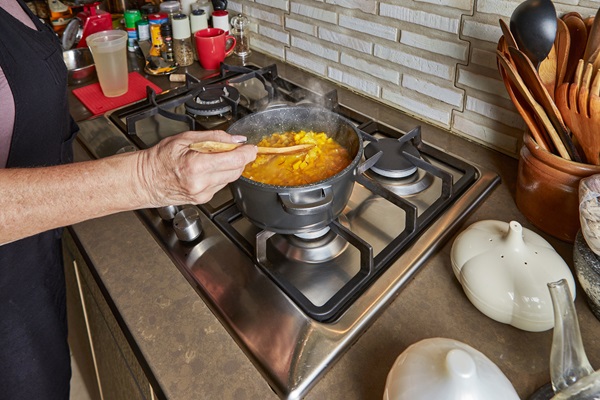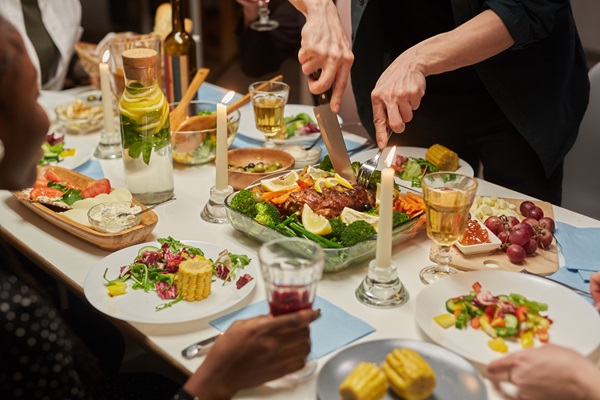Pulling off a dinner where every dish arrives at the table perfectly timed and at the right temperature is like conducting an orchestra; each section must be in sync. The challenge of having all your food dishes ready simultaneously is a dance of planning, precision, and practice. This guide is designed to navigate the complexities of meal coordination, ensuring that whether you’re hosting a feast or a cozy family dinner, every dish from the appetizer to the dessert is ready to impress. Unlock the secrets to a seamless dinner, transforming the usual kitchen chaos into a smooth culinary concert.
Contents
Planning Your Meal

Selecting the right dishes for your meal is foundational to timing everything perfectly. Opt for a balance of flavors and, more importantly, cooking times and methods. Consider how oven space, stovetop burners, and even grill or slow cooker can be maximized. This means choosing a mix of dishes that can be baked, simmered, sautéed, or served cold. The goal is to have a varied menu that allows different items to cook simultaneously or consecutively without a hitch.
Understanding the timing of each dish is crucial. Start by determining the total time each recipe requires, then work backward from your intended mealtime to establish a start time for each dish. Create a timeline or a chart if that helps visualize the sequence of cooking. Remember to factor in resting or cooling times for certain dishes. This backward scheduling is your roadmap, reducing last-minute rushes and ensuring each dish is given its due time to shine.
Organizing Ingredients and Cookware

Before any heat is turned on, organizing your ingredients (a practice known as mise en place) can significantly streamline your cooking process. Measure, chop, and arrange all your ingredients. This not only speeds up the actual cooking but also prevents the realization of missing ingredients midway through. Having everything in front of you means fewer distractions and more focus on timing and the cooking process itself.
Similarly, having all necessary pots, pans, and cooking utensils ready and at hand is vital. This means no rummaging through drawers for that one lid or spatula while your sauce is reaching a critical simmer. Ensure everything is clean, accessible, and appropriate for the task at hand. Consider the size and type of cookware for each dish, ensuring they are conducive to the cooking method and sequence you’ve planned.
Prioritizing Dishes Based on Cooking Time

Tackling the dishes with the longest cooking times first is a strategic move. Typically, roasts, braises, or slow-cooked items fall into this category. Getting these started first means they can cook relatively undisturbed while you prepare other components of the meal. It’s about setting a foundation and gradually building upon it with shorter cooking time dishes.
As these long-duration dishes simmer, roast, or bake, you can shift your attention to medium and short-time recipes. This might mean boiling or steaming vegetables, whipping up a quick salad, or sautéing a side dish. The key is to stagger the start times based on cooking duration, ensuring that all dishes are nearing completion around the same time, allowing for a symphony of flavors to come together at the dinner table.
Mastering the Art of Multitasking

Multitasking in the kitchen is about managing multiple dishes by understanding their cooking times and methods. It’s essential to keep a close eye on each dish, adjusting temperatures and timings as needed. The trick is to be nimble and responsive, shifting between tasks smoothly, such as stirring a pot while keeping an eye on the oven.
Safety and sanity are paramount when juggling multiple dishes. This means setting timers, keeping work areas clean and clutter-free, and perhaps most importantly, keeping a cool head. When the kitchen heats up with activity, a calm and organized approach will ensure that all dishes receive the attention they need, reducing the risk of overcooking or, worse, kitchen accidents.
Utilizing Kitchen Appliances Wisely

Using kitchen appliances effectively is a game-changer in preparing multiple dishes. The oven, stovetop, slow cooker, and even microwave should work in concert to optimize space and time. For instance, while the oven roasts a chicken, the stovetop can handle sauces and vegetables, and the microwave can be used for quick reheats or steaming. Planning which appliance to use for each dish, considering power and space limitations, ensures a smooth cooking process. This orchestration allows for simultaneous preparation, cutting down on total cooking time.
However, it’s also crucial to be mindful of the limitations and capacity of your appliances. Overloading circuits or crowding the oven can lead to uneven cooking or longer cooking times. Ensure that there’s enough space for heat circulation in the oven and that stovetop burners are used judiciously. Sometimes, cooking in batches or using alternative methods like grilling outside can provide relief to a busy kitchen. Balancing appliance use requires a strategic approach, aligning with your cooking timeline and the specifics of each dish.
The Role of Prep Work

Prep work is arguably one of the most critical aspects of cooking efficiently. Completing tasks like washing and chopping vegetables, marinating meats, or pre-assembling casseroles can save invaluable time during the cooking process. These steps, done ahead of time, mean fewer tasks to juggle when the heat is on. Pre-cooking certain components, such as grains or legumes, can also speed up the final cooking time. By investing time in prep work, you reduce the active cooking time needed for each dish, allowing for better focus on timing and quality.
Incorporating dishes that require minimal last-minute preparation can also alleviate kitchen congestion. Salads, cold appetizers, or desserts that can be made in advance and served cold or at room temperature are excellent complements to hot dishes. This not only spreads out the kitchen workload but also ensures there’s a variety of dishes ready to go at mealtime. The balance between pre-prepared and cooked-to-order dishes is a delicate dance that, when mastered, results in a seamless dining experience.
Adjusting As You Go

Flexibility in cooking is a valuable skill, especially when preparing multiple dishes. Sometimes, despite the best planning, adjustments need to be made on the fly. This could mean shifting something from the oven to a stovetop burner to free up space or altering the temperature of a dish to speed up or slow down its readiness. Being able to make these adjustments while maintaining the quality of each dish is crucial. It’s about being attuned to the progress of each component and ready to pivot as necessary.
Keeping dishes warm while others finish can be a challenge, but it’s crucial for ensuring that everything is ready at the same time. Utilizing warming drawers, low oven temperatures, or even insulated containers can keep food at the right temperature. It’s also helpful to know which dishes are forgiving if left to sit a little longer and which need to be served immediately. Managing these nuances ensures that each dish is served at its best, with every element coming together at the right moment.
Final Assembly and Presentation

The final steps of synchronizing completion and presenting the dishes are where all your efforts come to fruition. This involves the last touches like garnishing, carving, or assembling layers, ensuring each dish looks as good as it tastes. Timing is critical here; all dishes should be ready for these final steps around the same time to maintain their ideal temperature and freshness. The presentation is the culmination of your planning and hard work, the moment when the flavors, aromas, and visuals of your dishes merge to create a delightful dining experience.
Quick fixes and last-minute adjustments are often necessary in the kitchen. Whether it’s a sauce that needs thinning, a dish that requires a quick reheat, or a garnish added for freshness, being prepared to make these minor tweaks is part of the cooking process. This stage is about polishing and perfecting, ensuring that each dish not only tastes great but also contributes to the overall harmony of the meal. With everything in place, the meal is ready to be served, inviting diners to enjoy the delicious symphony of flavors you’ve expertly crafted.
Elevate Your Next Dinner Party
With the guide in hand, you are now equipped to elevate your next dinner party or family meal with grace and precision. The art of getting all your food dishes done at the same time is a skill that grows with each meal you prepare. Remember, every well-timed dish is a step closer to mastering the symphony of synchronized dinner preparation. Embrace the process, enjoy the journey, and relish the satisfaction of a meal that comes together perfectly. Here’s to many splendid dinners ahead!


